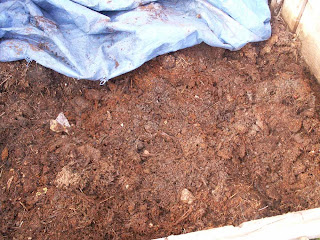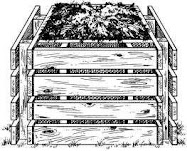Before we do I wanted to talk a little about getting th emost of outdoor spaces. We may try to save money on certain things but patio furniture is one thing that we need to spend on. There is nothing better than wicker furniture for helping us to enjoy our outdoor spaces. Rattan garden furniture can be bought quite inexpensively and is a great choice of garden furniture.
Composting and gardening in general is all about making the most of the outdoor spaces that we have. We should, if we can afford to, buy cheap patio furniture so we can enjoy not just gardening but relaxing in the garden as well. Now, on to the main point of this post.
What To Consider When You Build Compost Bins
Let's see what else we need to consider and then we can take a look at them in turn:
- The siting of the compost bin
- Where to make the compost bin
- A covering or not?
- Adequate moisture content
- How to prevent animals
Siting
When making a compost bin the siting is very important. You should consider it carefully as once it is there, especially once you start adding to it, there it will stay for some time. Garden composting should be made as easy as possible. This is why siting a homemade compost bin is so important. Think about where most of your organic material comes from and where you will be putting the compost once it is ready. Most of your compost may come from lawn clippings or it may come from the vegetable plot. In that case you may find it easier to site the composting bin you have made at the end of the lawn or a corner of the vegetable plot. These are all things worth considering.
When making a compost bin I always site them near to my chicken house and at the end of the vegetable garden. This way when I clean out the chickens or have spare veg it is easy to put all the contents on the composting heap without having to walk too far. Just have a think about where it will be most suited.
Where should you be building a compost bin?
There is no doubt that it will make life easier if, when making a compost bin, you can do it where it is intended to stay. For some designs, such as the wire compost bin I talked about in the post entitled Build Compost Bins From Chicken Wire, you have to build it in its final position. For other designs there is an option.
I really recommend levelling out the land and building it "in situ". This will save you energy as you will not have to move it after it is built. It will also mean that whatever composting bin you construct you know it will fit the space. You can adjust your measurements as you build the compost bin if you construct it at its final site.
Should You Cover The Compost Bin?
Adequate Moisture Content
 This can depend on the weather you get. If you get very wet weather a lot of the year then I would cover it. If you get very dry weather I would cover it. The best composters work at their peak if the contents are moist but not sodden. They also do not want to be too dry. There is a fine balance that needs to be achieved. When making a compost bin you should always bear this in mind. Use an old piece of carpet or a waterproof sheet of some kind. This will work for both wet or dry weather. It will both hold the rain off and also conserve the moisture that is present.
This can depend on the weather you get. If you get very wet weather a lot of the year then I would cover it. If you get very dry weather I would cover it. The best composters work at their peak if the contents are moist but not sodden. They also do not want to be too dry. There is a fine balance that needs to be achieved. When making a compost bin you should always bear this in mind. Use an old piece of carpet or a waterproof sheet of some kind. This will work for both wet or dry weather. It will both hold the rain off and also conserve the moisture that is present.I recommend keeping it covered whenever you get a prolonged dry or wet spell. Making a compost bin work at its best will mean you cover it for at least part of the year.
Preventing Animals
Animals, and rodents especially, can be a major problem for some garden composters. When choosing which composting bin you will make it is worth considering what type of animals may take an interest in it. We have both Dogs and Cats so we built our compost bin from pallets. This means the animals can not get access to the contents. To this end I also place one over the top of my homemade composting bin. They may want to get inside and have a root around but they cannot.
You may have a similar problem. Simply make a compost bin that will prevent whatever animals may be present from getting acces to the composting pile.
These are just a few things to keep in mind when making a composting bin.





No comments:
Post a Comment